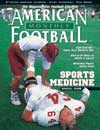AMERICAN FOOTBALL MONTHLY THE #1 RESOURCE FOR FOOTBALL COACHES
Article CategoriesAFM Magazine
|
The Truth About Turfby: Steve Silverman© More from this issue Your quarterback is on the run. Coming from his left is a 275-pound defensive end charging with a full head of speed. Coming straight at him is a blitzing middle linebacker. You watch from the sidelines and know the inevitable is about to happen. It's just a matter of who is going to get to your quarterback - the end or the linebacker. The linebacker wins the race. He explodes past a would-be blocker and wraps up the quarterback with a nasty hit punctuated by his head bouncing off the artificial turf surface. You hold your breath and pray. But then you have to act. What do you do next? A. Send out the trainer. B. Send out the ambulance C. Send out the backup quarterback D. Send in the next play. Five years ago, the answer might have been A, B and C. But that no longer has to be t....The full article can only be seen by subscribers. Subscribe today!
|
|
|||||||
| HOME |
MAGAZINE |
SUBSCRIBE | ONLINE COLUMNISTS | COACHING VIDEOS |
Copyright 2025, AmericanFootballMonthly.com
All Rights Reserved





